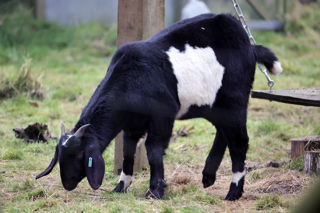
Anglo Nubian Goat
Capra hircus
The Anglo-Nubian goat is a distinguished British breed renowned for its dual-purpose utility in both meat and dairy production. Originating in the 19th century through the crossbreeding of native British goats with large lop-eared goats imported from regions such as India, the Middle East, and North Africa, this breed exhibits unique physical and performance characteristics.
Anglo-Nubians are characterized by their long, pendulous ears and a distinctive convex (Roman) nose. They possess a long, deep body with an upright stance, contributing to their majestic bearing. Their coats are short and glossy in females and somewhat longer and rougher in males. The breed showcases a wide array of colors, including black, chestnut, cream, fawn, and white, often in various patterns such as brindled, marbled, or mottled.
Main threats
Globally, the Anglo-Nubian goat is not considered at risk. However, in the United Kingdom, the breed is classified as endangered, underscoring the importance of conservation efforts within its native region.
Adaptability and global presence
The breed exhibits remarkable adaptability to hot climates, which has led to its presence in over sixty countries worldwide. In many regions, they are simply referred to as "Nubian" goats. Their ability to thrive in diverse environments has resulted in increased demand for their exportation to enhance both milk and meat production globally.
Favourite food
Grass, hay
Habitat
Grassland
Description
Size: 80-90cm
Weight: 110-140kg
Family facts
The Anglo-Nubian goat stands out for its distinctive physical features, high-quality milk, and efficient meat production. Its adaptability to various climates and global presence highlight its significance in both agricultural and cultural contexts.


